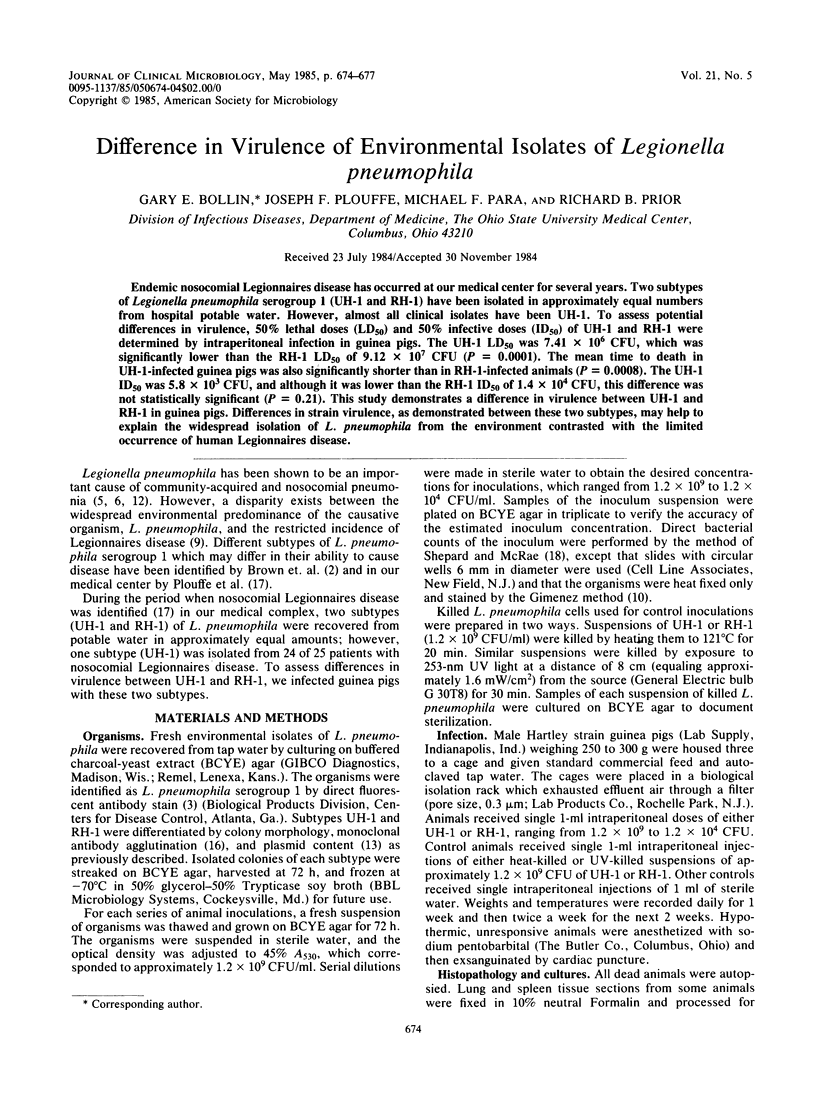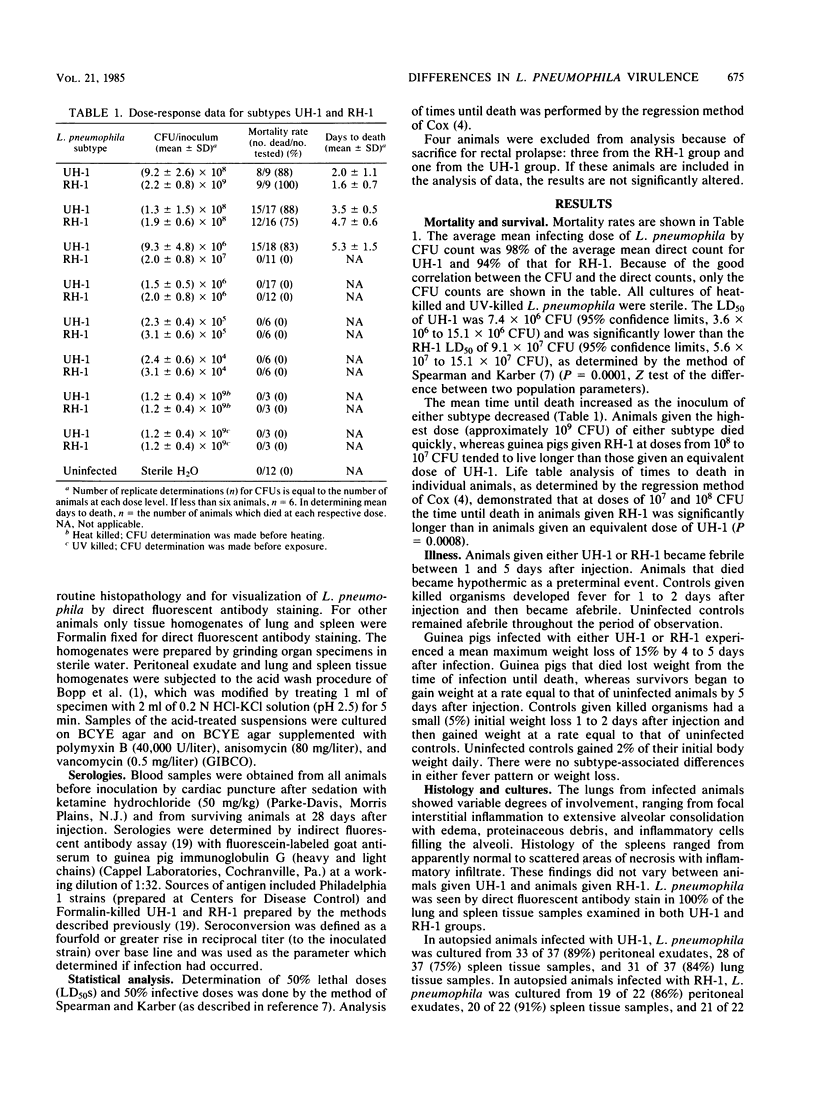Abstract
Endemic nosocomial Legionnaires disease has occurred at our medical center for several years. Two subtypes of Legionella pneumophila serogroup 1 (UH-1 and RH-1) have been isolated in approximately equal numbers from hospital potable water. However, almost all clinical isolates have been UH-1. To assess potential differences in virulence, 50% lethal doses (LD50) and 50% infective doses (ID50) of UH-1 and RH-1 were determined by intraperitoneal infection in guinea pigs. The UH-1 LD50 was 7.41 X 10(6) CFU, which was significantly lower than the RH-1 LD50 of 9.12 X 10(7) CFU (P = 0.0001). The mean time to death in UH-1-infected guinea pigs was also significantly shorter than in RH-1-infected animals (P = 0.0008). The UH-1 ID50 was 5.8 X 10(3) CFU, and although it was lower than the RH-1 ID50 of 1.4 X 10(4) CFU, this difference was not statistically significant (P = 0.21). This study demonstrates a difference in virulence between UH-1 and RH-1 in guinea pigs. Differences in strain virulence, as demonstrated between these two subtypes, may help to explain the widespread isolation of L. pneumophila from the environment contrasted with the limited occurrence of human Legionnaires disease.
Full text
PDF



Selected References
These references are in PubMed. This may not be the complete list of references from this article.
- Bopp C. A., Sumner J. W., Morris G. K., Wells J. G. Isolation of Legionella spp. from environmental water samples by low-pH treatment and use of a selective medium. J Clin Microbiol. 1981 Apr;13(4):714–719. doi: 10.1128/jcm.13.4.714-719.1981. [DOI] [PMC free article] [PubMed] [Google Scholar]
- Brown A., Vickers R. M., Elder E. M., Lema M., Garrity G. M. Plasmid and surface antigen markers of endemic and epidemic Legionella pneumophila strains. J Clin Microbiol. 1982 Aug;16(2):230–235. doi: 10.1128/jcm.16.2.230-235.1982. [DOI] [PMC free article] [PubMed] [Google Scholar]
- Cherry W. B., Pittman B., Harris P. P., Hebert G. A., Thomason B. M., Thacker L., Weaver R. E. Detection of Legionnaires disease bacteria by direct immunofluorescent staining. J Clin Microbiol. 1978 Sep;8(3):329–338. doi: 10.1128/jcm.8.3.329-338.1978. [DOI] [PMC free article] [PubMed] [Google Scholar]
- England A. C., 3rd, Fraser D. W., Plikaytis B. D., Tsai T. F., Storch G., Broome C. V. Sporadic legionellosis in the United States: the first thousand cases. Ann Intern Med. 1981 Feb;94(2):164–170. doi: 10.7326/0003-4819-94-2-164. [DOI] [PubMed] [Google Scholar]
- England A. C., 3rd, Fraser D. W. Sporadic and epidemic nosocomial legionellosis in the United States. Epidemiologic features. Am J Med. 1981 Mar;70(3):707–711. doi: 10.1016/0002-9343(81)90601-x. [DOI] [PubMed] [Google Scholar]
- Fitzgeorge R. B., Baskerville A., Broster M., Hambleton P., Dennis P. J. Aerosol infection of animals with strains of Legionella pneumophila of different virulence: comparison with intraperitoneal and intranasal routes of infection. J Hyg (Lond) 1983 Feb;90(1):81–89. doi: 10.1017/s0022172400063877. [DOI] [PMC free article] [PubMed] [Google Scholar]
- Fliermans C. B., Cherry W. B., Orrison L. H., Smith S. J., Tison D. L., Pope D. H. Ecological distribution of Legionella pneumophila. Appl Environ Microbiol. 1981 Jan;41(1):9–16. doi: 10.1128/aem.41.1.9-16.1981. [DOI] [PMC free article] [PubMed] [Google Scholar]
- GIMENEZ D. F. STAINING RICKETTSIAE IN YOLK-SAC CULTURES. Stain Technol. 1964 May;39:135–140. doi: 10.3109/10520296409061219. [DOI] [PubMed] [Google Scholar]
- Kirby B. D., Snyder K. M., Meyer R. D., Finegold S. M. Legionnaires' disease: report of sixty-five nosocomially acquired cases of review of the literature. Medicine (Baltimore) 1980 May;59(3):188–205. [PubMed] [Google Scholar]
- Maher W. E., Plouffe J. F., Para M. F. Plasmid profiles of clinical and environmental isolates of Legionella pneumophila serogroup 1. J Clin Microbiol. 1983 Dec;18(6):1422–1423. doi: 10.1128/jcm.18.6.1422-1423.1983. [DOI] [PMC free article] [PubMed] [Google Scholar]
- McDade J. E., Shepard C. C. Virulent to avirulent conversion of Legionnaires' disease bacterium (Legionella pneumophila)--its effect on isolation techniques. J Infect Dis. 1979 Jun;139(6):707–711. doi: 10.1093/infdis/139.6.707. [DOI] [PubMed] [Google Scholar]
- Ormsbee R. A., Peacock M. G., Bickel W. D., Fiset P. A comparison of some biologic characteristics of isolates of the Legionnaires' disease bacterium. Ann Clin Lab Sci. 1981 Jan-Feb;11(1):53–62. [PubMed] [Google Scholar]
- Para M. F., Plouffe J. F. Production of monoclonal antibodies to Legionella pneumophila serogroups 1 and 6. J Clin Microbiol. 1983 Oct;18(4):895–900. doi: 10.1128/jcm.18.4.895-900.1983. [DOI] [PMC free article] [PubMed] [Google Scholar]
- Plouffe J. F., Para M. F., Maher W. E., Hackman B., Webster L. Subtypes of Legionella pneumophila serogroup 1 associated with different attack rates. Lancet. 1983 Sep 17;2(8351):649–650. doi: 10.1016/s0140-6736(83)92531-x. [DOI] [PubMed] [Google Scholar]
- Shepard C. C., McRae D. H. A method for counting acid-fast bacteria. Int J Lepr Other Mycobact Dis. 1968 Jan-Mar;36(1):78–82. [PubMed] [Google Scholar]
- Wilkinson H. W., Fikes B. J., Cruce D. D. Indirect immunofluorescence test for serodiagnosis of Legionnaires disease: evidence for serogroup diversity of Legionnaires disease bacterial antigens and for multiple specificity of human antibodies. J Clin Microbiol. 1979 Mar;9(3):379–383. doi: 10.1128/jcm.9.3.379-383.1979. [DOI] [PMC free article] [PubMed] [Google Scholar]
- Winn W. C., Jr, Chandler F. W. Role of virulence factors in Legionella infections. Arch Pathol Lab Med. 1982 Mar;106(3):105–107. [PubMed] [Google Scholar]


